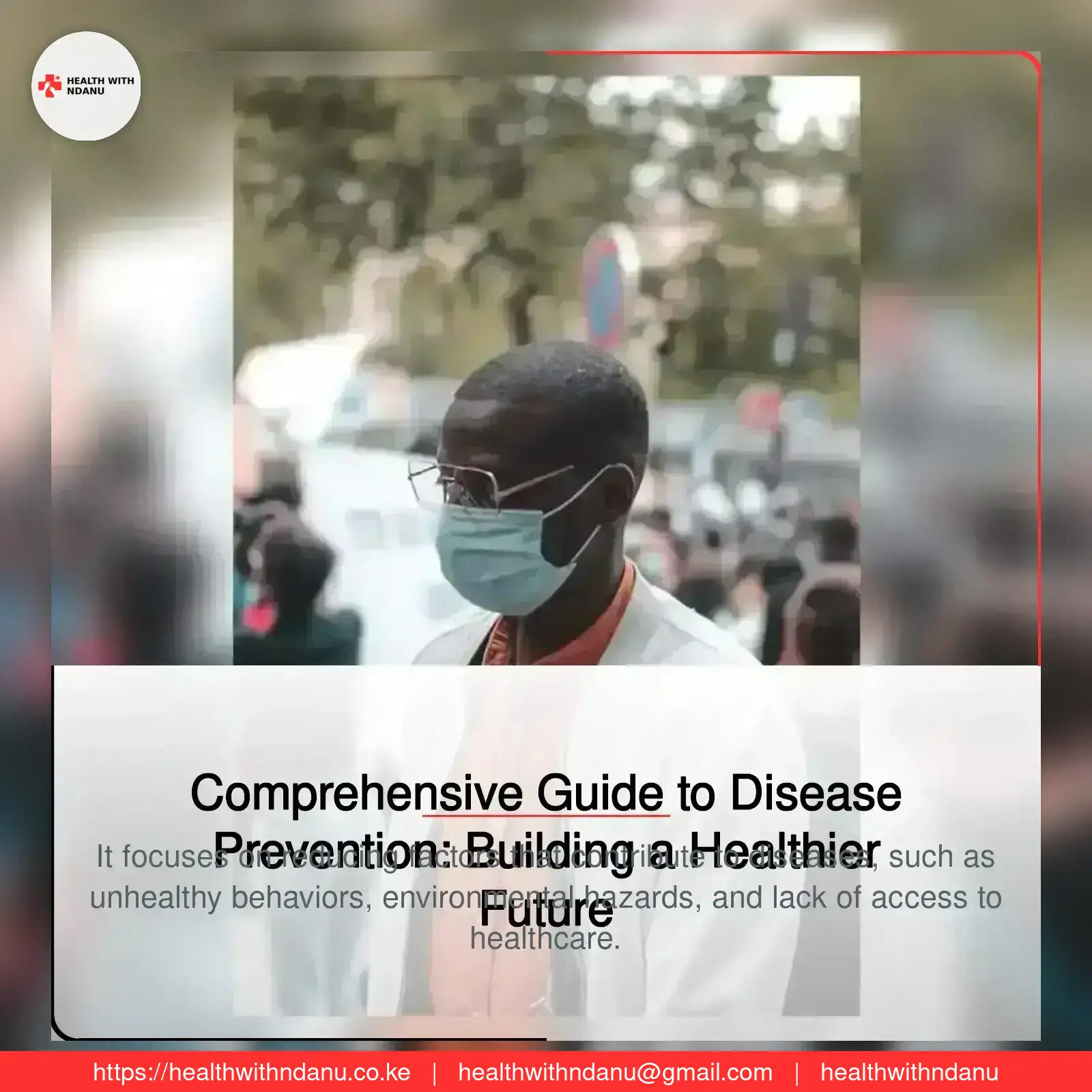Comprehensive Guide to Disease Prevention: Building a Healthier Future
- by Diana Ndanu
- 04 December, 2024
- 0 Comments
- 6 Mins



Introduction
Disease prevention is a cornerstone of public health, emphasizing proactive measures to reduce the risk of illnesses before they occur. With the increasing prevalence of chronic diseases and global health challenges, prioritizing prevention over treatment has never been more critical.
In this article, we’ll explore the types of disease prevention, effective strategies for maintaining health, and the benefits of adopting preventive measures.
What Is Disease Prevention?
Disease prevention encompasses efforts to mitigate health risks and avoid the onset of illnesses. It focuses on reducing factors that contribute to diseases, such as unhealthy behaviors, environmental hazards, and lack of access to healthcare. The goal is to enhance overall well-being and reduce the burden on healthcare systems.
Disease prevention is categorized into three primary types:
1. Primary Prevention:
Preventing the occurrence of diseases by addressing risk factors and promoting health through lifestyle changes.
2. Secondary Prevention:
Early detection and intervention to halt disease progression, such as screenings and regular check-ups.
3. Tertiary Prevention:
Managing existing diseases to minimize complications and improve quality of life.
The Importance of Disease Prevention
1. Reduces Healthcare Costs
Preventive measures are often more cost-effective than treating diseases. For instance, vaccination programs and lifestyle interventions save billions in healthcare expenses globally.
2. Enhances Quality of Life
Prevention helps individuals live healthier, longer lives free from the pain and limitations of chronic diseases.
3. Promotes Community Health
By reducing the spread of communicable diseases and addressing public health risks, prevention strengthens communities and reduces the strain on healthcare infrastructure.
4. Supports Economic Stability
Healthy individuals contribute to a productive workforce, which positively impacts economic growth.
Common Risk Factors for Diseases
To effectively prevent diseases, it’s essential to understand the risk factors, which can be categorized as:
-
Behavioral Factors
Smoking, excessive alcohol consumption, poor diet, and lack of physical activity.
-
Biological Factors:
Genetics, age, and gender. Environmental Factors: Exposure to pollution, unsafe drinking water, and occupational hazards.
Social Determinants of Health:
Income, education, and access to healthcare. Effective Strategies for Disease Prevention
1. Healthy Lifestyle Choices Balanced Nutrition:
A diet rich in whole grains, lean proteins, healthy fats, fruits, and vegetables is key to disease prevention. Avoid processed foods, excessive sugar, and unhealthy fats.
- Regular Physical Activity: Engage in at least 150 minutes of moderate-intensity aerobic activity or 75 minutes of vigorous exercise per week. Exercise improves heart health, strengthens immunity, and reduces the risk of chronic diseases.
- Adequate Hydration: Drink enough water daily to maintain bodily functions and flush out toxins.
- Weight Management: Maintaining a healthy weight reduces the risk of conditions such as diabetes, hypertension, and heart disease.
2. Vaccinations and Immunizations
Vaccines are a vital tool in preventing communicable diseases such as influenza, measles, and COVID-19. Ensure you and your family stay up-to-date with recommended vaccinations.
3. Regular Health Screenings
Early detection of diseases increases the chances of successful treatment. Regular check-ups for blood pressure, cholesterol levels, and cancer screenings are crucial for secondary prevention.
4. Hygiene Practices
Adopting simple hygiene practices, such as handwashing, can prevent the spread of infectious diseases. Ensure proper sanitation and safe food handling to reduce the risk of foodborne illnesses.
5. Avoid Risky Behaviors
Quit smoking and avoid secondhand smoke exposure. Limit alcohol consumption to moderate levels. Practice safe sex to prevent sexually transmitted infections (STIs).
6. Stress Management
Chronic stress weakens the immune system and increases the risk of illnesses. Incorporate relaxation techniques like meditation, yoga, or deep breathing into your daily routine.
7. Adequate Sleep
Sleep is vital for physical and mental health. Adults should aim for 7-9 hours of quality sleep each night to boost immunity and reduce the risk of chronic diseases.
Preventing Chronic Diseases Chronic diseases, such as heart disease, diabetes, and cancer, are among the leading causes of death worldwide. Prevention strategies include:
1. Heart Disease Prevention
- Follow a heart-healthy diet low in saturated fats and high in fiber.
- Engage in regular cardiovascular exercise.
- Monitor blood pressure and cholesterol levels regularly.
2. Diabetes Prevention
- Maintain a healthy weight and stay physically active.
- Opt for low-glycemic-index foods to stabilize blood sugar levels.
- Get screened if you have a family history of diabetes.
3. Cancer Prevention
- Avoid tobacco use and limit alcohol intake.
- Use sunscreen to protect against skin cancer.
- Consume antioxidant-rich foods like berries, nuts, and leafy greens.
Preventing Communicable Diseases
1. Boosting Immunity
Eat a nutrient-rich diet with immune-boosting foods like citrus fruits, garlic, and yogurt. Exercise regularly to improve immune function.
2. Infection Control Measures
Wear masks in crowded or high-risk areas. Disinfect frequently-touched surfaces, especially during flu seasons.
3. Global Vaccination Programs
Support immunization campaigns to curb the spread of diseases like polio, measles, and COVID-19.
The Role of Mental Health in Disease Prevention
Mental health and physical health are interconnected. Poor mental health can lead to unhealthy habits, such as overeating or substance abuse, which increase the risk of diseases.To prioritize mental health:
- Practice mindfulness and stress-relieving techniques.
- Build a strong support system of family and friends.
- Seek professional help if needed.
Community and Government Efforts in Disease Prevention
Preventive healthcare requires collaboration between individuals, communities, and governments. Key initiatives include:
- Health Education Campaigns:Raise awareness about lifestyle changes and preventive measures.
- Public Policies: Implement laws to reduce smoking, promote vaccination, and improve access to healthcare.
- Workplace Wellness Programs: Encourage employers to provide health screenings and wellness incentives.
Benefits of Disease Prevention
1. Healthier Communities
Preventive measures reduce the prevalence of diseases, leading to healthier populations and reduced healthcare burdens.
2. Economic Advantages
Fewer diseases mean lower healthcare costs for individuals and governments.
3. Improved Longevity
By preventing diseases, individuals can enjoy longer, more fulfilling lives.
Conclusion
Disease prevention is an essential component of a healthy and productive life. By adopting a proactive approach to health through lifestyle changes, vaccinations, and regular screenings, we can significantly reduce the burden of both chronic and communicable diseases. Prevention is always better than cure. Start your journey toward better health today by embracing preventive measures that safeguard your well-being and contribute to a healthier future for all.
Got Your Own Experience? Share with us
Kategoria Maarufu
Blogu Zinazotembelewa Zaidi
Daily Newsletter
Get all the top stories from Blogs to keep track.



